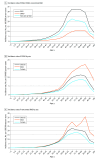Incidence of Retinal Artery Occlusion and Related Mortality in Korea, 2005 to 2018
- PMID: 36897587
- PMCID: PMC12527418
- DOI: 10.1001/jamanetworkopen.2023.3068
Incidence of Retinal Artery Occlusion and Related Mortality in Korea, 2005 to 2018
Abstract
Importance: It remains unclear whether comorbidities in patients with retinal artery occlusion (RAO), a rare retinal vascular disorder, differ by subtype and whether mortality is higher.
Objective: To examine the nationwide incidence of clinically diagnosed, nonarteritic RAO, causes of death, and mortality rate in patients with RAO compared with that in the general population in Korea.
Design, setting, and participants: This retrospective, population-based cohort study examined National Health Insurance Service claims data from 2002 to 2018. The population of South Korea was 49 705 663, according to the 2015 census. Data were analyzed from February 9, 2021, to July 30, 2022.
Main outcomes and measures: The nationwide incidence of any RAO, including central RAO (CRAO; International Statistical Classification of Diseases and Related Health Problems, Tenth Revision [ICD-10] code, H34.1) and noncentral RAO (other RAO; ICD-10 code, H34.2) was estimated using National Health Insurance Service claims data from 2002 to 2018, with 2002 to 2004 as the washout period. Furthermore, the causes of death were evaluated and the standardized mortality ratio was estimated. The primary outcomes were the incidence of RAO per 100 000 person-years and the standardized mortality ratio (SMR).
Results: A total of 51 326 patients with RAO were identified (28 857 [56.2%] men; mean [SD] age at index date: 63.6 [14.1] years). The nationwide incidence of any RAO was 7.38 (95% CI, 7.32-7.44) per 100 000 person-years. The incidence rate of noncentral RAO was 5.12 (95% CI, 5.07-5.18), more than twice that of CRAO (2.25 [95% CI, 2.22-2.29]). Mortality was higher in patients with any RAO than in the general population (SMR, 7.33 [95% CI, 7.15-7.50]). The SMR for CRAO (9.95 [95% CI, 9.61-10.29]) and for noncentral RAO (5.97 [95% CI, 5.78-6.16]) showed a tendency toward a gradual decrease with increasing age. The top 3 causes of death in patients with RAO were diseases of the circulatory system (28.8%), neoplasms (25.1%), and diseases of the respiratory system (10.2%).
Conclusions and relevance: This cohort study found that the incidence rate of noncentral RAO was higher than that of CRAO, whereas SMR was higher for CRAO than noncentral RAO. Patients with RAO show higher mortality than the general population, with circulatory system disease as the leading cause of death. These findings suggest that it is necessary to investigate the risk of cardiovascular or cerebrovascular disease in patients newly diagnosed with RAO.
Conflict of interest statement
Figures



Comment in
-
Long-term Management Considerations for Retinal Artery Occlusion and Cardiovascular and Cerebrovascular Mortality.JAMA Netw Open. 2023 Mar 1;6(3):e233076. doi: 10.1001/jamanetworkopen.2023.3076. JAMA Netw Open. 2023. PMID: 36897594 No abstract available.
References
MeSH terms
LinkOut - more resources
Full Text Sources

